Blockchain and distributed databases are significant advancements in data management strategies. Blockchain, known for its application in cryptocurrencies, extends to other domains, such as finance and healthcare, offering decentralization, transparency, and security. Meanwhile, distributed databases store data across multiple locations and excel in scenarios requiring reliability, scalability, and efficiency. While both systems involve data decentralization but have unique operational mechanisms, benefits, and drawbacks, understanding these nuances is critical to effectively utilize these tools in our increasingly data-dependent world. Blockchain, at its core, is a type of digital ledger. Think of it as a record-keeping book where each new piece of information forms a new page - a 'block.' Each block is then added chronologically to the 'chain' of previous blocks. What sets blockchain apart from a standard database is that once a block is added, it becomes virtually unchangeable or 'immutable,' guaranteeing the authenticity and integrity of the stored data. The arrival of Bitcoin, a digital cryptocurrency, catapulted blockchain technology into the spotlight. The primary function of blockchain lies in its ability to offer a trusted, secure, and decentralized way of recording digital transactions. This means it eliminates the need for an intermediary, such as a bank, to oversee these transactions. Blockchain's importance comes from its ability to sustain trust between unknown parties involved in an online transaction, a groundbreaking quality that continues to impact industries worldwide. In the realm of blockchain, transactions are recorded and stored within blocks. Each block is then cryptographically linked to the previous one, creating a chain of blocks. The participants in this network, often referred to as 'nodes,' are responsible for maintaining and validating the blockchain. A blockchain block is like a digital basket holding numerous transactions. Before being placed in the block, each transaction is verified by the network nodes using complex cryptographic algorithms. Once a block is filled with validated transactions, it is added to the blockchain, and a new block begins its lifecycle. Consensus mechanisms are the backbone of a blockchain network. They ensure that all nodes in the network agree on the validity of transactions. There are several types of consensus mechanisms, but the most popular are the Proof-of-Work (PoW) and Proof-of-Stake (PoS). Blockchain's design promotes unparalleled transparency, which fosters trust among its users. As every participant in the network has access to the entire blockchain, it becomes easy to track and identify fraudulent transactions. Blockchain's inherent security measures make it one of the most secure technologies today. The cryptographic linking of each block makes tampering with the information contained within extremely challenging. To alter a single block, a hacker must alter every subsequent block, a task requiring immense computational power. In the world of blockchain, the concept of decentralization is paramount. Unlike traditional databases overseen by central authorities, blockchain allows direct peer-to-peer interactions, removing the need for an intermediary. One of the prominent hurdles facing blockchain technology is scalability. As the size of the blockchain increases with the addition of new blocks, the time and computational resources needed to validate and add transactions also increase. This can lead to reduced transaction speeds and higher costs. Blockchain networks, particularly those using the Proof-of-Work consensus mechanism, are notoriously energy-hungry. These networks require significant computational power to function, leading to high energy consumption and raising concerns about the technology's environmental impact. Despite its potential to disrupt various sectors, blockchain faces significant regulatory challenges. Given its novelty and the changes it brings to traditional systems, many jurisdictions are grappling with how to adapt existing laws and regulations to fit this new paradigm. A distributed database is a database system with storage devices not attached to a common processor. These storage devices could be spread across multiple computers within the exact physical location or dispersed over a network of interconnected computers across different locations. The primary objective of a distributed database is to offer an effective, efficient, and scalable way to store and manage large volumes of data. This system enables organizations to distribute data storage and processing loads across multiple servers or nodes, often leading to significant improvements in performance and reliability. In a distributed database environment, the system disseminates information across all network nodes. To bolster reliability and accessibility, it frequently utilizes data replication. This involves copying and maintaining database objects in multiple databases that are part of the distributed system. A protocol known as atomic commit is used to maintain consistency in distributed databases. This protocol ensures that a transaction is reflected in all databases, or none of them, thus maintaining data integrity across the network. Distributed databases leverage various query optimization techniques to enhance efficiency. These techniques aim to execute any given logical query in the least amount of time, thereby improving the overall performance of the database system. As data is replicated across several nodes in the network, distributed databases offer a high degree of reliability and availability. If one node goes offline or fails, the data can still be retrieved from another, ensuring continuous access to critical information. Distributed databases shine in their ability to scale. As an organization's data needs grow, more nodes can be added to the system without causing a significant decline in performance. By allowing multiple nodes to process queries simultaneously, distributed databases often offer superior efficiency compared to traditional databases. Managing a distributed database can be complex, given the large number of nodes involved and the need for consistent transactions across all nodes. This complexity increases with the system's scale and the nodes' geographical distribution. Maintaining consistency across a distributed database can pose challenges. Any changes made to one node must be replicated across all nodes. Achieving this level of consistency requires sophisticated synchronization protocols and mechanisms. Since data is spread across multiple nodes, each node in a distributed database can be a potential point of attack. This increases security concerns and demands robust security measures to protect data integrity and confidentiality. While both systems distribute data across multiple nodes, they manage control and authority differently. Blockchains operate without any central authority in a fully decentralized manner. Distributed databases, however, often have centralized control points despite the distributed nature of their data. Blockchains excel at providing transparency and fostering trust among unknown participants in a network. In contrast, trust within distributed databases is typically established through controlled access and identifying known users or entities. The use case also determines whether a blockchain or distributed database would be more appropriate. Blockchain technology is particularly useful when trust, transparency, and decentralization are essential, such as with cryptocurrencies. On the other hand, distributed databases are better suited for environments where large amounts of data need to be managed efficiently and reliably, such as in large corporations or institutions. Choosing between a blockchain and a distributed database depends on various factors. These include the need for transparency and trust, the level of required decentralization, scalability requirements, efficiency, and the specific needs of the use case. It's important to remember that the landscape of technology is constantly evolving. Both blockchain and distributed databases are seeing ongoing advancements that aim to address their respective challenges and enhance their capabilities. Blockchain and distributed databases represent two distinctive approaches toward data management. Blockchain stands out for its unparalleled transparency, trustworthiness, and decentralization, making it ideal for applications such as cryptocurrencies. However, it grapples with scalability and energy consumption issues. Conversely, distributed databases excel in handling large volumes of data, offering reliability, scalability, and efficiency. Yet, they can be complex and may have security concerns. Deciding between the two is contingent on multiple factors, including the need for trust, degree of decentralization, scalability, and particular use case requirements. As the technological landscape rapidly evolves, both these data management systems continue to improve, promising increased potential and broader applications in the future.Overview of Blockchain and Distributed Database
What is Blockchain?
Definition
Purpose and Importance
How Blockchain Works
Cryptography and Network Participants
Transaction and Block Structure
Consensus Mechanisms
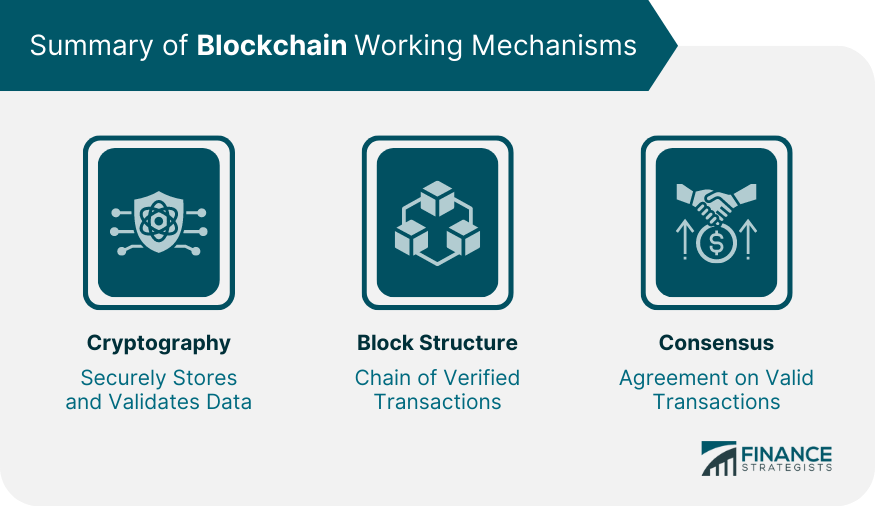
Advantages of Blockchain
Transparency and Trust
Security
Decentralization
Challenges of Blockchain
Scalability
Energy Consumption
Regulatory Uncertainties
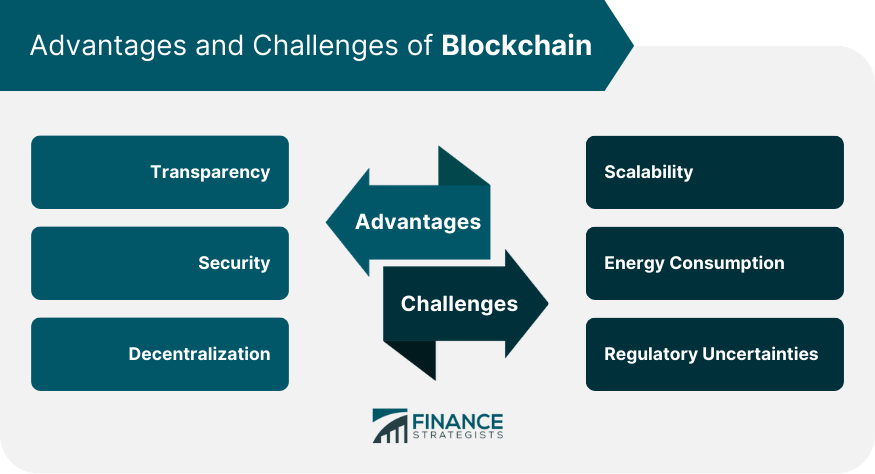
Understanding Distributed Database
Definition
Purpose and Importance
How a Distributed Database Works
Data Distribution and Replication
Data Consistency
Query Optimization
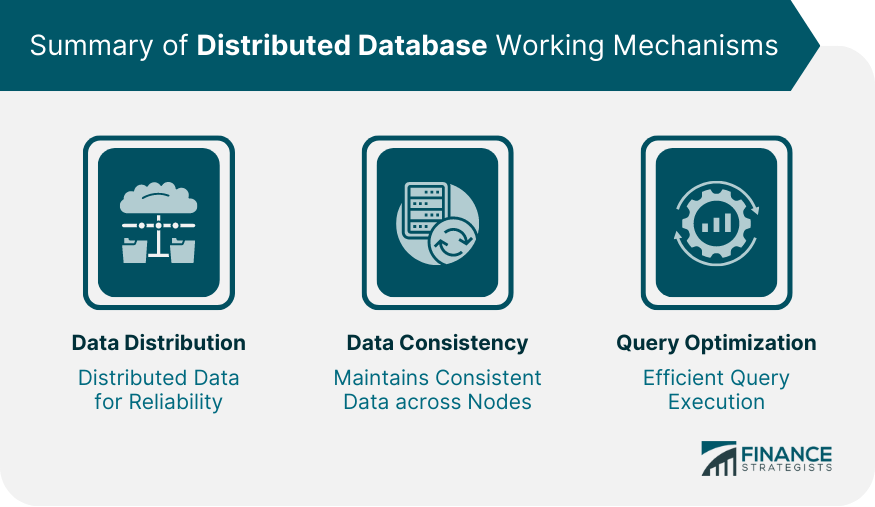
Advantages of a Distributed Database
Reliability and Availability
Scalability
Efficiency
Challenges of a Distributed Database
Complexity
Consistency Issues
Security Concerns
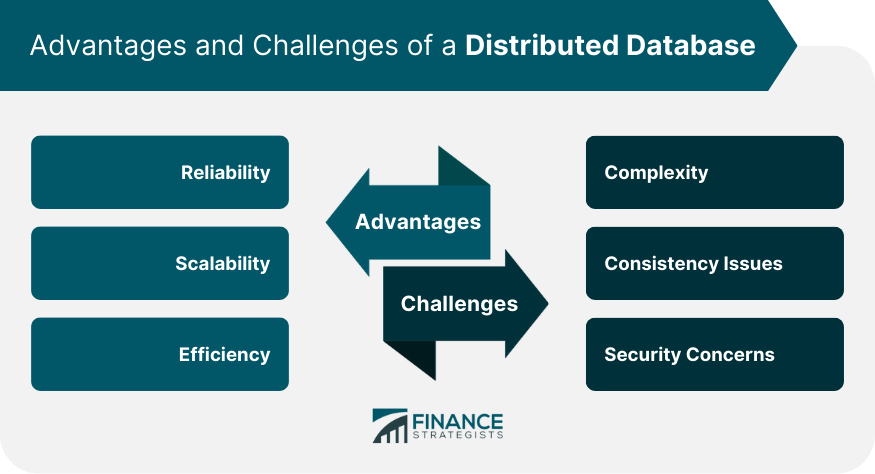
Blockchain vs Distributed Database: Core Differences
Decentralization and Authority
Transparency and Trust
Specific Use Cases
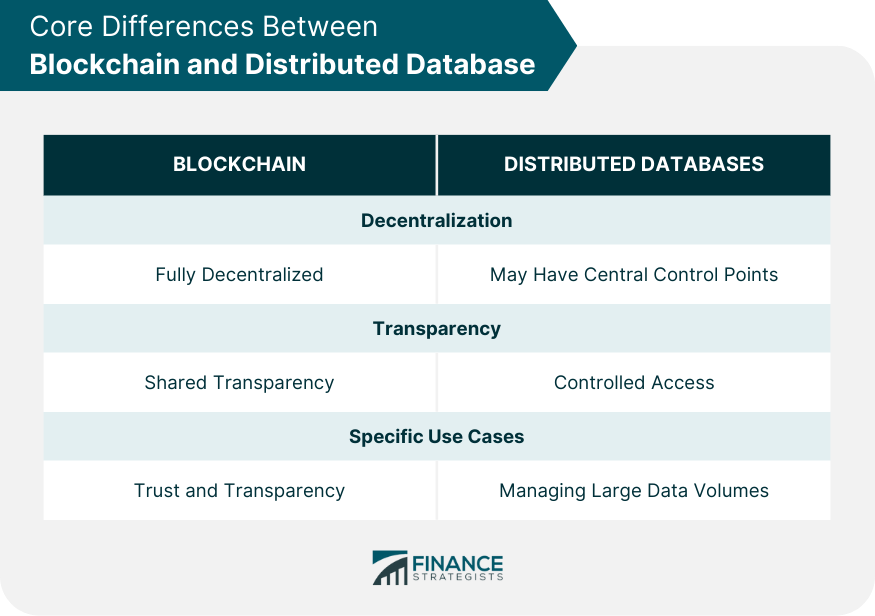
Making the Decision: Blockchain or Distributed Database?
Determining Factors
Technological Progress and Implications
Conclusion
Blockchain vs Distributed Database FAQs
Blockchain is an immutable digital ledger used for recording transactions in a decentralized manner. A distributed database is a system where data is stored across multiple locations for efficient, scalable data management.
Blockchain offers transparency, security, and decentralization but faces issues with scalability, energy consumption, and regulation. Distributed databases provide reliability, scalability, and efficiency but face complexity, consistency issues, and security concerns.
Blockchains are fully decentralized, transparent, and ideal for cases requiring trust and transparency. Distributed databases, while distributing data, may have central control points and are suited for managing large volumes of data.
The decision depends on various factors, including the need for transparency and trust, the level of required decentralization, scalability requirements, efficiency, and the specific needs of the use case. As technology evolves, both systems are undergoing improvements to address their challenges and enhance their capabilities.
The technological landscape is constantly evolving, leading to ongoing advancements in both blockchain and distributed databases. These advancements aim to address their respective challenges and enhance their capabilities. As these data management systems continue to improve, they promise increased potential and broader applications in the future.
True Tamplin is a published author, public speaker, CEO of UpDigital, and founder of Finance Strategists.
True is a Certified Educator in Personal Finance (CEPF®), author of The Handy Financial Ratios Guide, a member of the Society for Advancing Business Editing and Writing, contributes to his financial education site, Finance Strategists, and has spoken to various financial communities such as the CFA Institute, as well as university students like his Alma mater, Biola University, where he received a bachelor of science in business and data analytics.
To learn more about True, visit his personal website or view his author profiles on Amazon, Nasdaq and Forbes.













